To understand what happens next, you have to understand a thing or two about roller coaster manufacturers – the companies that design the roller coasters we encounter at theme parks every day. There are dozens and dozens of well known manufacturers with names that probably sound familiar like Premier, Vekoma, Zierer, CGI, Rocky Mountain Construction, Mack... Today, we'll focus on the big three that make a difference in the tragic tale of Drachen Fire.
Arrow Dynamics
Image: Andrew Borgan, Flickr (license)
Any discussion of modern steel coasters has to start with Arrow Dynamics. Arrow was the manufacturer responsible for the Matterhorn Bobsleds at Disneyland, the first tubular steel-tracked coaster on Earth. Through the 1970s, Arrow was a staple, manufacturing classic looping and corkscrewing roller coasters for seemingly every major park in the United States.
Arrow’s coasters all share a distinctive look from their crisscrossed lattice support structures (see Cedar Point's Corkscrew, above) to their track, and more often than not, they share a distinctive ride experience: with many of Arrow's rides built in an era before computer modeling could precisely detect the speed and forces along every inch of track, Arrow’s rides often have a bit of reputation for roughness. You can, for example, often look at the track ahead of you and see an awkward transition or a jarring turn ahead.
Think, for example, of the wild ejector air on Cedar Point's Magnum XL-200 (so very different from modern, computer-calculated out-and-back hypercoasters), the snapping turns on Kings Island's Adventure Express or your local park's Arrow mine train, or your local park's classic double-looping coaster, a multi-inversion coaster made up of seemingly random loops and corkscrews and hills. This distinctive style feels like an Arrow coaster.
Image: Jeremy Thompson, Flickr (license)
Arrow today no longer exists. The manufacturer quite literally bankrupted itself in the creation of Six Flags Magic Mountain’s ultra-complex roller coaster X (now X2), with Arrow’s assets living on through another ride manufacturer S&S Sansei, who specializes in air-pressure powered coasters, flat rides, and drop towers.
In our story today, it's important to note that the only two roller coasters Busch Gardens Williamsburg had in the age of Drachen Fire were Big Bad Wolf and Loch Ness Monster – both Arrow creations.
INTAMIN
Image: Chun Yip So, Flickr (license)
Much more recognizable to modern audiences is INTAMIN, a Swiss manufacturer known internationally for pushing boundaries with stunning results.
Intamin was the first to cross the 300-foot height barrier with Cedar Point’s Millennium Force (2000) and pioneered using an innovative elevator-cable lift system to do it; they returned to the same park with 2003’s Top Thrill Dragster, the first to cross the 400-foot barrier, this time using a hydraulic winch launch. Cedar Point’s Maverick is another, with its LSM launch and its winding, wild, layout of seemingly random twists meant to feel like a buckin' bronco. Intamin is also responsible for the smooth-as-glass, laser-cut Plug-and-Play line of wooden coasters like the extreme El Toro, and prototype ride systems like Superman: Escape from Krypton and Green Lantern: First Flight at Six Flags Magic Mountain.
Image: Patrick McGarvey, Flickr (license)
Intamin pushes boundaries, and sometimes they push back. Their rides can be known for extended downtime, frazzling computer systems, and going a bit too far. The only sister ride to Millennium Force, Kings Dominion’s Intimidator 305 (2010) was so intense, riders routinely blacked out in its first helix, necessitating a major, total reprofiling of the ride's first manuevers. Initial test runs of Maverick showed that one of the inversions placed excessive G-forces on the trains, necessitating a delay to the ride's opening and the inversion's replacement with a straight section of track. The cable launch system used on rides like Top Thrill Dragster or Knott's Berry Farm's Xcelerator have both frayed in the past, spraying metallic shrapnal on riders. In 2013, the relatively new Shoot the Rapids log flume at Cedar Point rolled backwards down the ride's lift with the boat flipping backwards into the flume at the bottom. Riders in over-the-shoulder restraints were trapped underwater for minutes – likely leading to the ride's removal in 2016.
In other words, Intamin innovates and, from time to time, pays the price.
Bolliger and Mabillard
Image: Jeremy Thompson, Flickr (license)
Bolliger and Mabillard. The very name of the Swiss manufacturer conjures very specific images in the minds of theme park aficionados. B&M, as they’re commonly known, is renowned the world-over for its tried-and-true roller coasters. Unlike Intamin’s constant push to innovate, B&M always stuck to what they knew: super-smooth, ultra-reliable steel coasters with perfectly paced elements. While they may tinker with train set-ups and high-brow concepts, at their core B&M is known in the coaster community for crowd-pleasing, go-to rides with ultra-high up-time.
B&M's iconic "cobra roll" manuever in which the track resembles a striking cobra. Image: Jeremy Thompson, Flickr (license)
If your local park contains a smooth, steel, out-and-back roller coaster made of perfectly arcing airtime hills (Diamondback, Behemoth, Apollo’s Chariot, Nitro, Raging Bull, Mako, etc.), a smooth, ultra-wide diving coasters (Valravn, Griffon, SheiKra, Swarm), a smooth winged coaster (Gatekeeper, X-Flight, Wild Eagle, Thunderbird), or a smooth Inverted coaster (Banshee, Raptor, Great Bear, Batman: The Ride, Dragon Challenge, etc.) then you’ve got a B&M.
B&M is so enamored with reliability and effortless operation, they famously refused to engineer a launch system for Universal's Incredible Hulk. They agreed to design, engineer, and build Islands of Adventure's starring coaster, but insisted that a third party would need to develop the launch system, as such glitchy, divisive systems didn't fit into their simple, reliable line-up. Sure, they've since created complex ride systems (flying coasters like Manta, Tatsu, Air, and the Flying Dinosaur) and even manufactured a single launched coaster themselves (Holiday World's Thunderbird), but tried-and-true has been B&M's bread-and-butter.
And that’s where our story resumes.
1990s
In 1988, Walter Bolliger and Claude Mabillard – recently having departed from the company that supplied rides to Intamin – were approached by Six Flags and asked if they could design a roller coaster for Six Flags Great America just outside of Chicago. They did, and in 1990, Iron Wolf opened. The unique ride was a standing coaster, with riders standing upright instead of sitting. While it wasn't the first, it was the premiere of what would become B&M's distinctive style of four-abreast trains, "pre-drops" at the top of the lift to reduce stress on the chain, and precisely planned layouts... very different from what other manufacturers at the time (like Arrow) were offering.
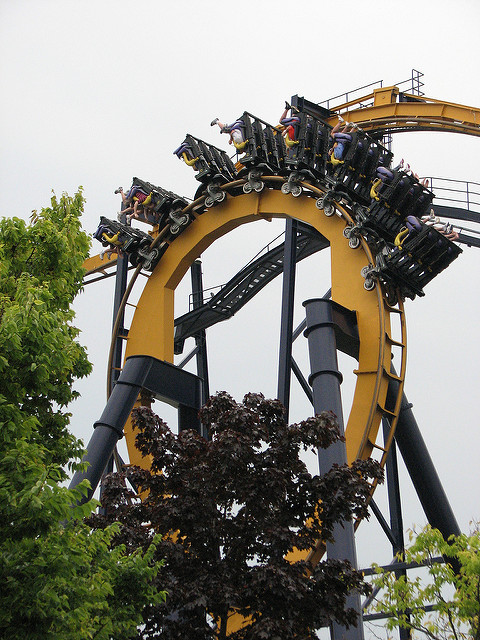
Image: Jeremy Thompson, Flickr (license)
But that was just the start. In 1992, just two years later, B&M opened another roller coaster at Six Flags Great America: Batman: The Ride (above). This unique ride was an entirely new kind of roller coaster that B&M called an Inverted coaster. Unlike traditional roller coasters, the Inverted coaster sat four across and hung beneath the track like a ski lift with riders’ legs dangling freely. Batman: The Ride opened to rave reviews and Six Flags put in a bulk order. At once, B&M’s schedule filled up as absolutely everyone wanted an Inverted roller coaster. To date, 12 exact clones of Batman: The Ride have been built, and almost every major amusement park on Earth features a B&M Inverted roller coaster.
So when Busch Gardens contacted B&M about building a pair of groundbreaking new roller coasters at its Floridian and Virginian park, B&M regrettably declined; they already had two roller coasters on their docket for 1993 (both Inverted), four more in 1994. They were booked. After a bit of reasoning and pleading, Busch Gardens convinced B&M to sway. They would design one roller coaster for Busch Gardens, but only one. Busch Gardens Tampa would receive Kumba.
If the Williamsburg park were to have a ride that would complement Kumba, B&M would not be the ones to create it. Their schedule was simply too full. But with the concept of Kumba in hand, Busch was able to approach another manufacturer: Arrow. The creators of the park’s two existing coasters – Loch Ness Monster and Big Bad Wolf – would be optioned to create the complement to Kumba, going directly off the concepts provided by B&M. Drachen Fire would open in 1992.
It would be one of the most unusual roller coasters to ever exist. And it didn’t exist for long. Take a ride on Drachen Fire on the next page…
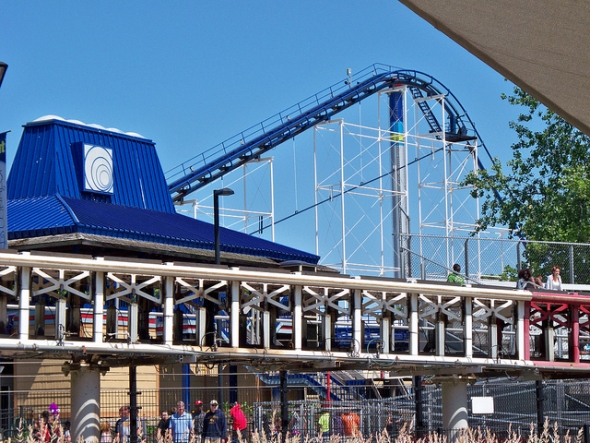
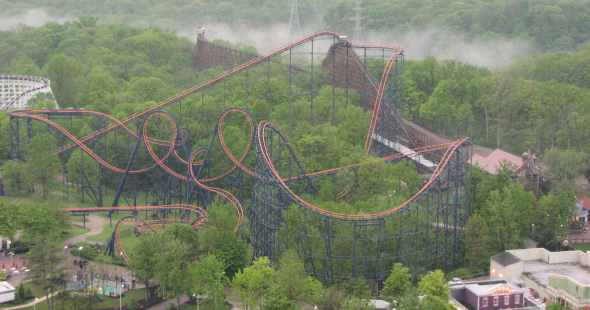
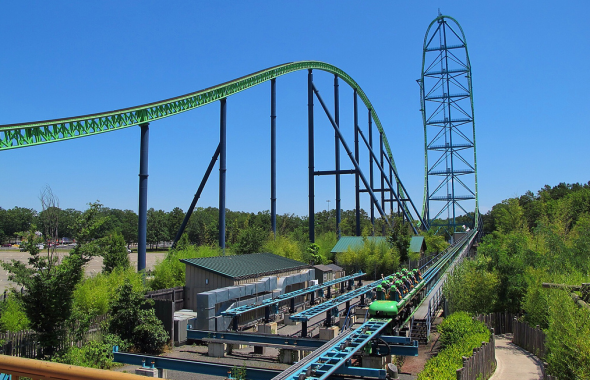
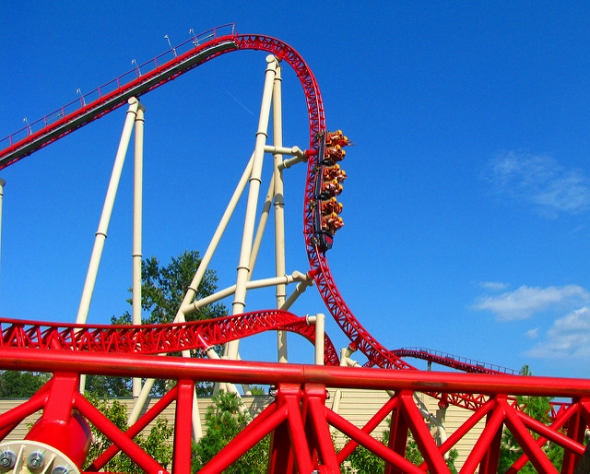
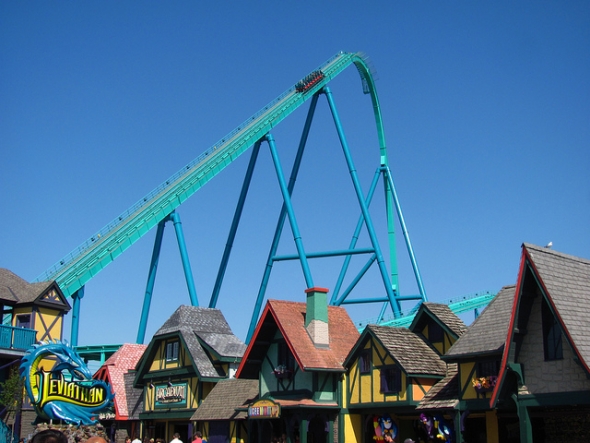
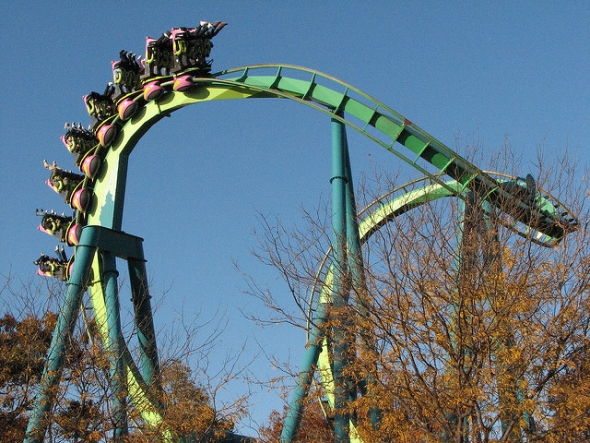

Comments
I thought this article was going to be about Shock Wave that used to be at Six Flags Great America back in the day. That thing was BRUTAL.E
I was glad i got a chance to ride this but as far as it being rough yes it was very rough and you got banged around alot but i dont think it was any more or les than scream machine did at great adventure
It's a shame that X bankrupt Arrow as Dollywood's Tennessee Tornado they finally got it right. A very smooth Arrow coaster.
Thanks for doing this one. I've been reading all your others and was hoping you'd do Drachen Fire. I rode it as a kid an loved it. But even as a kid I remember it banging the crap out of me. Now I understand why.
Thanks again for all the lost legends articles. They are fascinating. Keep it up
thx
JD
I think this is my favorite Lost Legends article. Having grown up at Busch Gardens Tampa and having never visited the one in Virginia, it was interesting reading about the dualities of the two parks. It was also nice that you broke down the different coaster manufacturers to explain why this coaster was so different. I'm enjoying the articles that are digging deep into parks outside of Disney.